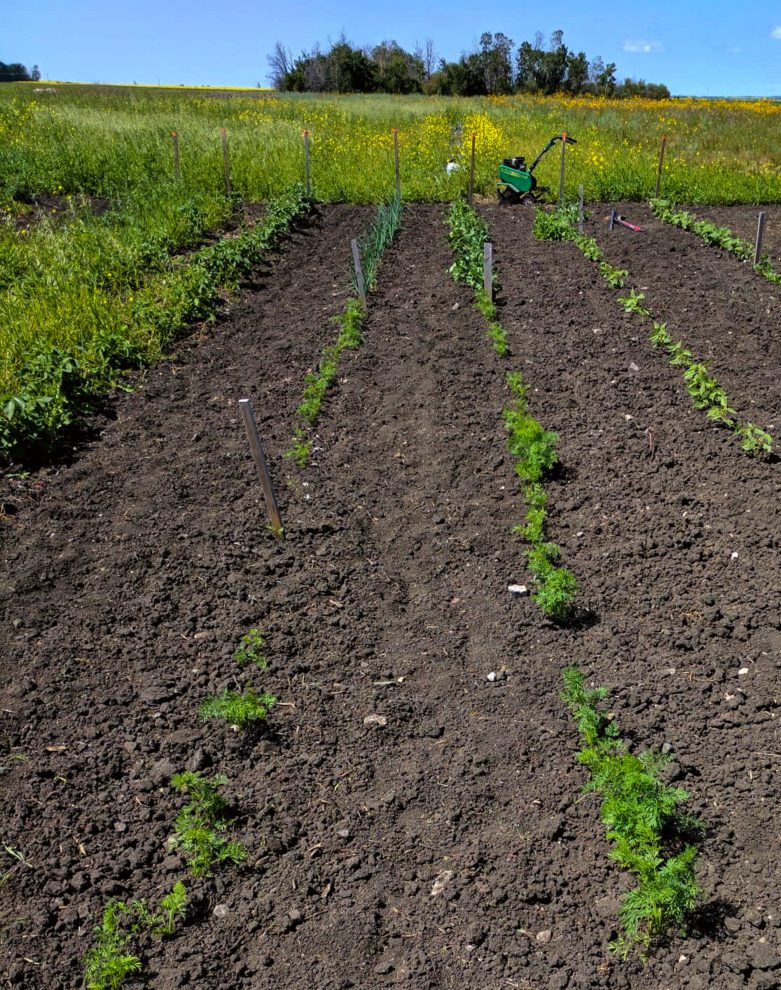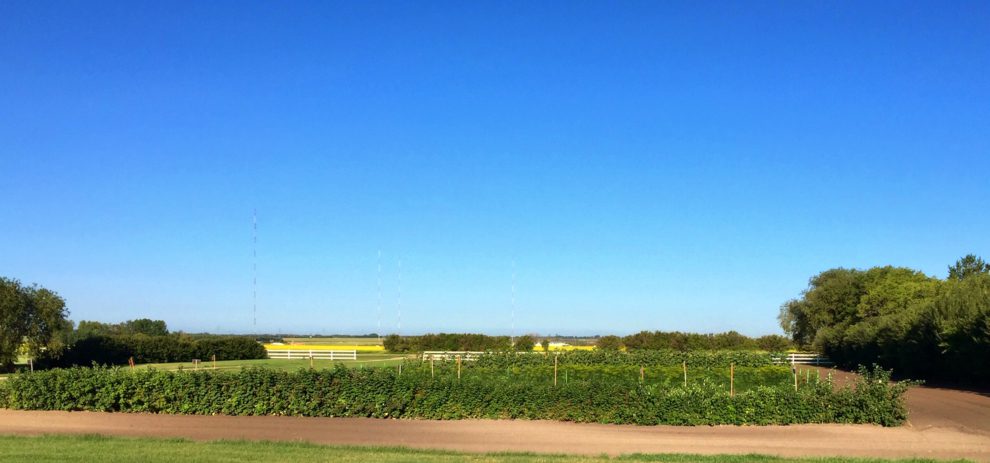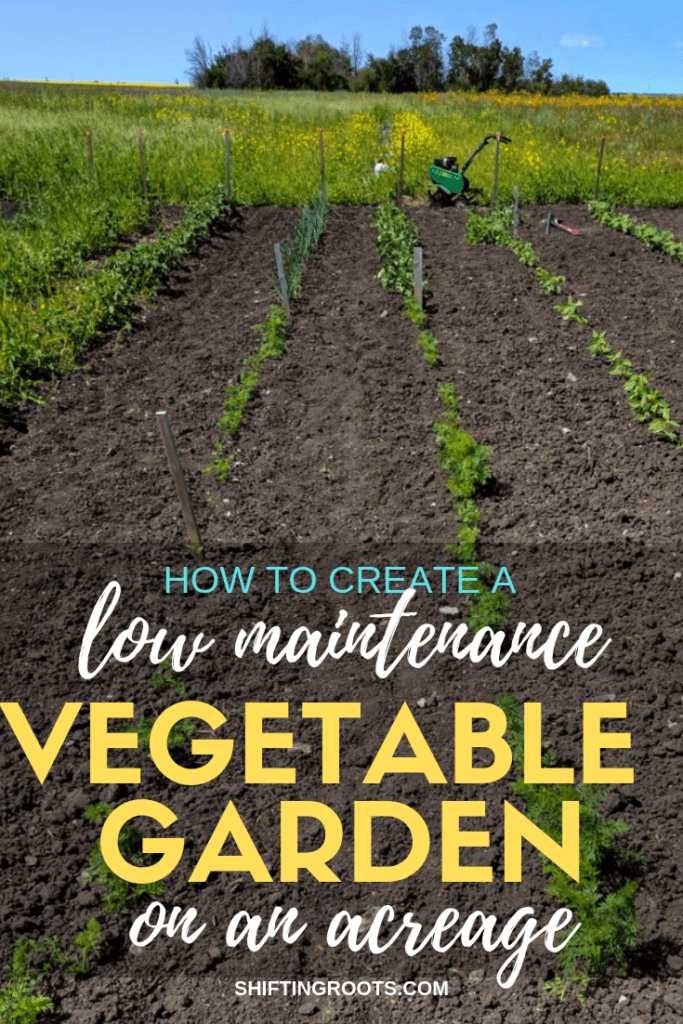You’ve just bought an acreage and are starting the life you’ve always dreamed of. You want a garden, but that garden space that came with the property is just so big and overwhelming–a brown blank canvas that you have no idea what to do with and no idea how you’re going to keep the weeds down with all the other yard work you have to do.
Here’s how you can keep your vegetable garden as low maintenance as possible on an acreage.

This post contains affiliate links, which means that if you purchase anything I earn a small commission at no extra cost to you. You can read more about it in my Privacy Policy. Thanks for supporting Shifting Roots!
1. If You’re Starting From Scratch, Start Small–and Use Cardboard.
If you’re new to gardening and have a large blank canvas of a landscape to work with, start small.
It’s okay if your vegetable garden feels like a postage stamp in your backyard. There’s so much yard work on an acreage that you want to do everything you can to keep yourself from getting overwhelmed.
My favourite method to start a new garden space is to lay down cardboard.
If you’re able to lay down the cardboard in the fall, you can rototill it in and start a new vegetable garden relatively weed-free. If you need to start your vegetable garden in the spring, you can put at least 4-6 inches of soil directly on top of the cardboard. The vegetable garden won’t be the best you’ve ever had, but you’ll still be able to grow vegetables and it will be relatively weed free.
P.S. Need some help figuring out what’s a weed and what’s a plant? Click here!
2. Grass Clippings=Free and Abundant Mulch
Growing up on a small farm, I was responsible for cutting the lawn every week. I loved the job, but it took me 4-5 hours to do on a riding lawnmower. The good news was, every week it produced lots of free mulch that could be used in our garden to keep the weeds down.
If your grass has a lot of weeds you might not want to use them, but in my opinion, the few resulting weeds will be far less than the amount of weeds if you didn’t mulch at all. You know your yard and your tolerance for weeds, so the choice is ultimately up to you.
Planning to mulch this year? Here’s what you need to know.
Also, if you have the budget for a chipper shredder, you can easily make your own mulch year-round from dead trees and leaves around the property. This mulch is far better than using grass if you’re able to make it for yourself.
3. Have a Plan for Any Space You Rototill
A rototiller is a great tool, but if you’re not willing to pick out the weeds and grass that grow back time after time, or keep roto-tilling every week or two, you need a plan.
If you’re roto-tilling a new vegetable garden, plant only potatoes the first year and cover the non-vegetable space with cardboard and mulch.

If it’s an established vegetable garden, plan on laying down mulch between the rows, or consider moving to planting your vegetables square foot gardening style.
You’ll still have to do an initial big weeding 3-4 weeks after you plant, but after that the vegetables will crowd out the weeds, leaving considerably less work for you to do.
Plan the Perfect Garden

Get your free Garden Planner and worksheets and start creating the garden of your dreams.
4. Use Tarps for Vining Vegetables
Vegetables like cucumbers, melons, squash, and pumpkins take up a lot of space, but in the early days of growing there’s a lot of bare soil that just begging for weeds to grow in it.
The solution?
Lay down a tarp and poke holes in for the vegetables. The ground stays weed free and you only have to weed the area where you made the hole for the vegetable.
One caveat–make sure you create a bit of a well where the vegetables are planted, so that the water can get to them when it rains.
Write what vegetable you planted in what hole on the tarp, and reuse it every year.

5. Raised Beds Work for Acreage Gardens Too
Just because you live on an acreage doesn’t mean you have to rototill your garden and plant things in rows. You can convert your current garden to raised beds so everything becomes easier to manage.
I really like the raised bed setup that Jess has at Roots and Refuge.
If you prefer a raised bed garden kit, I like these options in wood, vinyl, and metal.
6. Protect Your Garden From Pests
While I can’t possibly go into every pest you might run into on a acreage, there are certainly more to deal with when you’re out in the country. If your budget allows, consider fencing in your garden to protect from deer, rabbits, and other wildlife.
Fencing also helps protect your your tender seedlings from the wind when you first put them out in the garden.
I hope these tips help you avoid the overwhelm of having a large vegetable garden space and that you have a weed-free and low-maintenance gardening season! Have any tips to add? Share with us in the comments?


Alicia
Kristen Raney
Amber
Kristen Raney
Kristen Raney